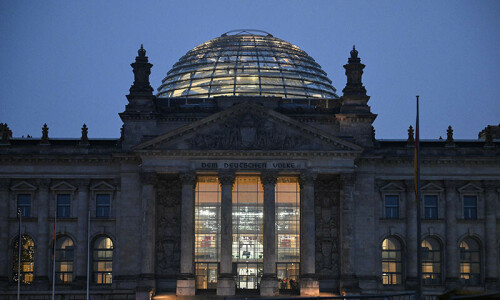 |
| This photo combo shows, left, a general view of the ancient Roman city of Palmyra, northeast of Damascus, Syria, released on May 17 by the Syrian official news agency SANA. The photo on right, released on Aug 25, on a social media site used by self-styled Islamic State militants, shows smoke after the detonation of the 2,000-year-old temple of Baalshamin in Palmyra.—AP |
IN May 2015, the self-styled Islamic State group captured the modern city of Palmyra. The adjoining Unesco world heritage site is a breathtaking archaeological complex like no other. In the 2nd century AD this oasis city in the Syrian desert was one of the grandest and wealthiest places in the world, with a total population about the size of modern Cardiff. Much of the ancient civic and sacred architecture still survives. Perhaps most evocative is the colonnaded street more than one kilometre in length: in antiquity, caravan traders from all over the Middle East would have processed along this road with their spices and silks towards the city’s religious heart, the magnificent temple of Bel, eyed from above by hundreds of statues of Palmyrene benefactors.
The future of this extraordinary site is precarious. At the time of the initial occupation, an anti-Assad Syrian radio station carried an interview with Abu Laith al-Saoudi, an IS commander, who vouched that only the idolatrous statues would be destroyed; “concerning the historical city we will preserve it and it will not undergo damages”. Whatever deity reigns in IS fantasy firmament, however, must have been in a capricious and malign mood.
On Aug 23, it was reported that the temple of Baal Shamin, one of the best-preserved and most unique buildings on the site, had been levelled by explosives.
Palmyra is not just a spectacular archaeological site, beautifully preserved, excavated and curated. It also offers antiquity’s best counterexample to IS’s fascistic monoculturalism. The ancient city’s prosperity arose thanks to its citizens’ ability to trade with everyone, to integrate new populations, to take on board diverse cultural influences, to worship many gods without conflict. Painful though it is to say it, and unlikely though it is that its asinine followers realise it, IS have chosen their target exceptionally well.
The city rose to prominence in the 1st century AD. It was a natural stopping-off point for those travelling from the western cities of Damascus, Emesa (modern Homs) or Apamea, to the Euphrates valley in the north. Most valuable of all for its prosperity, however, were the southern and south-eastern routes down to the Red Sea and the Arabian Gulf, which brought exotic goods from India, Indonesia and China. The archaeological remains testify to the moment when the entire Eurasian land mass joined up, culturally speaking. It grew rich from the taxes (up to 25 per cent) levied on market goods — and, of course, on the water and provisions that a bustling oasis city could monopolise.
Ethnically, the first settlers were Arabs and Aramaeans. As the city grew, local nomads put down roots, and then immigrants from further afield. Incoming communities preserved cultural links by retaining the gods of their homelands.
Palmyra had an extraordinary variety of gods, deriving from territories as far afield as modern Iraq, Saudi Arabia, Palestine and Lebanon. There was also the mysterious “god with no name” — the object of much scholarly speculation. But the city had a strong collective identity too. Ancient middle-eastern cities tended to worship gods in triads, and Palmyra was no exception: Bel, Yarhibol and Aglibol were acclaimed by the whole city, regardless of ethnicity. The imposing, iconic temple of Bel still stands, at the end of that kilometre-long colonnade — for now, at least.
It is surely high on the IS hit list.
Ancient Palmyra was also defined by its political geography. To the east lay the massive empire of the Zoroastrian Parthians, centred in modern Iran. To the west was the Mediterranean basin, dominated by Rome. It was Rome that first pushed its boundaries eastwards to encompass Palmyra, adding another layer of cultural richness. But the columns, capitals and pediments that dominate the temple architecture, and the theatre, baths and aqueduct, were not forcibly imposed by the Romans; the Palmyrenes actively chose to absorb these features of a distant civilisation, having first attracted the craftsmen to build them. They also opted for Greek forms of civic governance for their city, which was managed by a council made up of the local gentry — exactly the same set-up as in Athens, Corinth or Delphi.
This combination of cultural hybridity and economic savvy was in fact so successful that Palmyra developed imperial ambitions of its own, which erupted forcefully in the 3rd century AD, when Zenobia famously proclaimed herself Queen, and for a time seized from the Romans large parts of Syria, and Arabia too, threatening to expand into Egypt. The Emperor Aurelian eventually put down the insurrection and re-established Roman control. Zenobia’s defeat marked the beginning of the end of Palmyra’s exuberant diversity and archaeological splendour. Within 100 years, the Roman Empire was Christian, and the opportunities for theological and hence architectural inventiveness were gone. In the 7th century came Muslim occupation, and in time the city was absorbed into the Damascus-based Umayyad caliphate.
Although Christians and Muslim occupiers repurposed the ancient city’s buildings as churches, fortresses and mosques, however, they left them largely intact. It has taken a savagery distinctive to the 21st century to threaten their destruction altogether. Syria’s heritage is under attack now from an unprecedentedly toxic combination of religious absolutism, facile identity politics, postcolonial grievance, incendiary technology and adolescent folly. That it is Palmyra at risk, antiquity’s icon of cultural diversity, is a horrible irony.
—By arrangement with The Guardian
Published in Dawn, August 27th, 2015
On a mobile phone? Get the Dawn Mobile App: Apple Store | Google Play











































